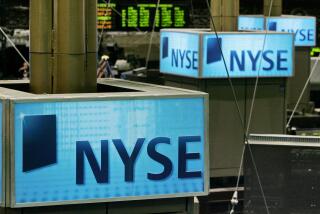Unrealistic Pension Accounting Scrutinized
- Share via
The stock market just wrapped up its third straight year of losses, but when it comes to pension accounting, that reality has yet to catch up with much of corporate America.
Many companies are feeding their bottom line by assuming their pension assets will grow by at least 10% a year in the future, despite widespread concern that the current market slump hasn’t ended.
The practice is receiving increasing scrutiny as investors fret over whether companies are using aggressive estimates to pump up earnings.
That’s because complex accounting rules require companies to book pension income based on estimates rather than actual losses or gains.
As a result, the higher a company forecasts its return on pension plans, the higher its earnings, irrespective of how the pension assets really perform.
At the start of 2002, companies in the Standard & Poor’s 500 on average estimated that their pension assets -- the bulk of which are invested in the stock market -- would post lofty returns of 9.3% for the year, according to a study by Merrill Lynch & Co.
Some analysts say investors should start getting nervous and question expected return rates above 8% or 9%.
“Investors should get worried, first of all, when they see companies with high expected rates of return -- it flies in the face of the move toward more conservative accounting and suggests the company is reaching for earnings,” said David Hawkins, an accounting consultant with Merrill Lynch.
Companies and other analysts argue that these estimates are based on long-term models and are not meant to change with year-to-year fluctuations in the stock market.
“This rate is generally chosen not to look back at what’s happened over the last year or two; it’s meant to be looking forward from now on, what is a reasonable average long-term rate of return,” said Larry Sher, director of research at Buck Consultants, an actuarial consulting firm and unit of Mellon Financial Corp.
Take, for example, US Bancorp, which forecast an 11.6% expected return in 2001, making it one of those with the highest assumptions in the S&P; 500.
It then revised that estimate to 11.9% for the first two quarters of 2002, before lowering it to 9.9% for the last two quarters of the year. It expects to continue using a 9.9% return this year, a spokesman said.
The company defends those estimates by saying it has a better chance of earning such returns over the long term because its pension plan is fully invested in the stock market.
Timber products company Weyerhaeuser Co., which assumed an 11% rate of return in 2001, reduced that estimate to 10.5% for 2002, but counters that it has one of the highest-performing pension funds in the United States, averaging about 18% annually.
Critics such as Merrill’s Hawkins, however, argue that companies aren’t likely to repeat double-digit returns of the last decade without another bubble similar to the tech boom of the late 1990s -- an unlikely prospect at the moment.
Plus, UBS Warburg’s accounting analyst David Bianco says growth assumptions over 7% or 7.5% are optimistic, even accounting for the long-term rate of return argument that companies offer.
That’s because on average, pension portfolios have 60% of their assets tied up in the stock market while the rest usually are locked up in debt or other assets that generate even lower returns.
More to Read
Inside the business of entertainment
The Wide Shot brings you news, analysis and insights on everything from streaming wars to production — and what it all means for the future.
You may occasionally receive promotional content from the Los Angeles Times.










